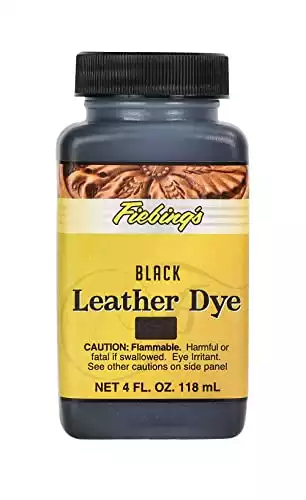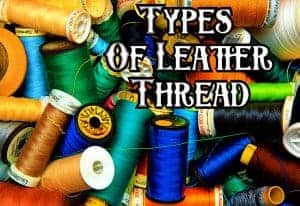
How to Darken Leather
There’s something so special about well-aged leather. I love the story it tells; there’s something so unique about every piece of darkened leather. I also love watching leather darken as it grows older.
But, if you’re working on your on doing your own leather projects, it’s important for you to learn how to darken leather. Even if it’s an old leather project, you likely know that leather tends to fade over time. Thankfully, there are plenty of ways you can darken leather at home ( with or without dye) in just a few simple steps!
I’m going to tell you all about how to darken your leather at home as long as you follow my steps. Let’s get started!
Bottom line up front: You can darken leather using coffee, walnut hulls, oils, dyes, or polish. Make sure you experiment with a piece of scrap leather before you apply the darkening agent to ensure you’re happy with the color before finishing up your project.
Darkening leather doesn’t have to be difficult. Make sure you clean, clean, clean before you start any darkening project. I would recommend you use Fiebing’s Leather Dye for any of your darkening projects!
Oil vs. Polish vs. Dye
The type of darkening agent you’ll want to use depends on the project you’re working on and your personal preferences.
Oil

Using oil to darken your leather may be the cheapest option available. You can use the coconut oil you have in your kitchen to darken your leather, which is probably a great option for you to consider if you aren’t sure if you’ll stick with leather-making for now. I know some people have recommended olive oil before. However, I’m not the biggest fan of olive oil. I’ve always found that leathers darkened with olive oil have a strange smell. I like the coconut oil that doesn’t leave a strong smell with it! Natural oils are great to darken leather with, especially if you’re on a budget.
A lot of people tend to use mink oil too. I’m not a big fan of using mink oil because it dulls the shine of the leather, giving it a matte appearance. However, if this is the look you’re going for, I’d recommend you look into mink oil!
Neatsfood oil is a type of natural oil (made from the bones of cows’ feet), but I don’t like this type of oil either. It causes leather to crack over time. I would really only recommend highly skilled professionals use neatsfood oil. I think there are a lot better natural oil options out there for you to consider.
I like to scoop some coconut oil out of the jar with a soft sponge. I’ll rub sections of the leather project in a back-and-forth motion. I never press hard on the leather; I always rub gently to make sure I don’t scratch or damage the leather.
Polish
I like using polish when I’m darkening large pieces of leather. The last big projects I worked on using leather polish were a large tote and an armchair. I picked up leather polish I found online, but there are also a lot of leather polishes available in store too!
All I do to darken my leather with polish is pretty simple. I’ll put some polish on a soft dry cloth, and I’ll dab the polish onto the leather. Any polish I put onto the couch, I’ll rub in a circular motion until I get the perfect shade I want!
Once I’ve got that perfect shade, I’ll take a second dry cloth and buff the polish into the leather. I’ll do this over the entire surface of the leather until the entire thing is evenly polished!
Leather Dye
Leather dyes are nice to use because they’re fast and pretty easy to use. I don’t feel like they require as much effort as leather polish or oil. I would recommend you use an oil-based leather dye. I like the oil-based dye more because it penetrates into the leather and leaves a much more even coating. I also like how it doesn’t take as much time to dry, so I’m able to move on from the darkening project faster. And while this may just be my opinion, I feel like the oil-based dyes look much more natural compared to the water-based dyes.
But that doesn’t make the water-based dyes bad!
I use a soft sponge and soak up some leather dye (it doesn’t matter if it’s oil or water-based). I’ll rub the dye into the leather using a circular motion. After I’ve made sure the entire section is properly coated in the dye, I move on to the next section. I always make sure to work in sections, so the entire project is colored evenly!
Once I’ve coated the entire project, I wait a day or two before I move it. As a pro tip, I don’t ever work on leather in direct sunlight. I’ve done that one too many times and ruined a project! Keep in mind that the leather will probably lighten up as it dries, so don’t be afraid to go back through this process again to get the perfect shade you’re looking for.
How to Darken Leather

Before you begin to darken any of your supplies, there’s one thing I want to talk to you about. Do you really want to darken your leather? I know I wished more people had warned me about darkening any leather projects. Not only are some of the options to darken your leather expensive, but there’s also a big risk you could ruin the entire project. That’s why I always recommend practicing on any scrap leather you have lying around!
Also, don’t forget the time. If you’re in a rush to darken your leather, it’s really important to consider certain darkening options compared to others. It’s a very time-consuming process, so don’t forget to budget in your schedule too.
Clean Your Leather
First and foremost, you’ll want to make sure your leather is clean. It’s really important to make sure you clean it off well, especially if it’s leather that’s sat in a dusty room. Any dirt or debris on top of the leather before you start darkening it will get trapped during the darkening process. I always use sticky tape or a lint roller to gently roll off all of the debris that’s on the leather. I’ll run a vacuum wand over the top after I use the lint roller.
After I take a lint roller and a vacuum over top of my leather, I’ll take room temperature water and dampen a cloth. Next, I’ll add a bit of dish soap and get the rag sudsy. I’ll mainly do this for bags, wallets, and clothing items. If I’m working with something larger, I’ll use a leather cleaner to really get in the cracks and crevices.
I’ll use this rag to wipe down the leather to make sure there isn’t any sticky residue, grease, or any other unwanted substances on top of the leather. Before I start anything else, I’ll let the leather air dry!
Step 2: Apply Your Conditioner or Dye
To darken your leather, you’ll want to apply a conditioner or dye. There are different processes for this, depending on whether you’re using a dye or a conditioner. You should read the instructions on the dye or conditioner before you put it on the leather.
Step 3: Let Dry
Once you’ve got your entire project coated the way you want it, it’s time to let it dry! After you’ve applied your darkening agent, make sure to keep your leather out of direct sunlight. This is especially important if you’re using oils to darken your leather. If you keep olive oil, coconut oil, or any other sort of natural oil, it can go rancid in the sunlight. This can cause the leather to smell really, really bad. I would recommend you let it dry in a cool space.
After letting your leather project dry for 24-48 hours, come back to check on it. At this point, if you decide you want the leather darker, you can apply more darkening agents!
My Favorite Leather Darkeners
If you’re unsure of where to begin your leather darkening journey, I’ve got a few tried and true leather dyes I’d highly recommend. All of these leather dyes I’ve personally used and discovered to be high-quality!
Fiebing’s Leather Dye

Fiebing’s Leather Dye – Alcohol Based Permanent Leather Dye | Amazon
Buy at Amazon.com
$9.30
Premium quality leather calls for premium quality care. Our superior formula is designed to restore luster, sheen and shine to high-end leather for all colors.
We earn a commission if you make a purchase, at no additional cost to you.
03/08/2024 07:11 pm GMT
If you’ve spent any time at all researching how to darken leather, chances are you’ve seen other people recommend this leather dye too. This is one of the best leather dyes in the whole world! I love this dye for so many reasons, but mainly because of how evenly it always applies. If you’re worried about messing up your project due to an uneven application, I would highly recommend this dye. Since it’s made with alcohol, you don’t have to worry about an uneven coating or any streakiness like you do with other darkening agents.
The only thing I don’t really like about this dye is how liquid it is. It gets very messy very quickly. As long as you’re aware of that before you start darkening your leather, you’ll be all good to go!
In my opinion, the best part of this dye is that it comes in so many different colors!
Hydrophane Darkening Oil

This is an oil, not a dye, so keep that in mind if you’re only looking for a dye! This is a great darkening oil because of how easy it is to apply. It works great on a variety of textures and projects. The only trick I use to make this oil work for projects with more textures/grooves is to soak my applicator with a little more oil. That way, I can get into all of those crevices!
Angelus Brand Leather Dye

This is another super famous leather dye. It’s great to use for many different things, but I love using this on handbags and totes! I’ve never had a problem with this dye cracking off or peeling, even on the older projects I worked on.
I always reach for this dye because of how pigmented it is. I feel like it lasts such a long time. I’m even able to work on big leather projects and not go through an entire bottle of this leather dye! I wouldn’t recommend this dye to a beginner, though, simply because of how pricey it is.
Rit All-Purpose Dye

Now, if you’re a beginner, this is the leather dye I’d recommend! I love this because it’s cheap, super easy to find (thanks, Walmart), and works incredibly well. You can use this on any type of leather project, including furniture and saddles! Plus, there are a bunch of different colors this dye comes in. So, if you’re looking to experiment with your leather project, you have plenty of room to do so, thanks to the Rit All-Purpose dye. However, I’m always reaching for black or dark brown.
Even better, you can use this on fabric too. So, if you have a project that you want to match completely with fabric, you don’t have to get another type of dye!
FAQs
Question: Does leather conditioner darken leather?
Answer: The leather conditioner works to protect the leather. However, it can cause the leather to become darker. This is because the majority of leather conditioners are oil-based, and oil can darken leather!
Question: Does honey darken leather?
Answer: No, honey in itself will not darken leather.
Question: Can you condition leather too much?
Answer: Yes, you can! Over-conditioning the leather can cause it to hold onto too much moisture, which will damage the leather over time.
Learning to darken leather
I’ve spent years figuring out the best tips for darkening leather, and this is all of the info I’ve learned. Fiebing’s Leather Dye is a great darkening dye that’ll work wonders on many of your leather projects. But if you’re not ready to step into the game with the big dogs, I would recommend the Rit All Purpose dyes. If you’d like to go even cheaper, coconut oil will do the trick. Before you work on anything, remember to carefully clean your leather. After that, you’ll be golden!
Looking for more interesting readings? Check out:




